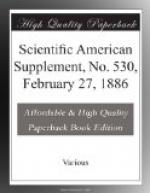In making these experiments it is not necessary to use a glass disk over the treated fibers. If a disk or cover is pressed on them while undergoing this treatment, the life-like motion of the silk will not be so apparent.
* * * * *
IMPROVED PYROMETER.
Mr. John Frew, Langloan Iron Works, Coatbridge, has been successful in perfecting a most ingenious pyrometer, an instrument which is capable of continuously indicating every variation of temperature with a remarkable degree of correctness. This instrument, which we here illustrate, has already become known to a number of proprietors and managers of blast furnaces; and on the occasion of the members of the Iron and Steel Institute visiting Coatbridge, in connection with the meeting of that body which was held in Glasgow last autumn, many persons became interested in its construction and in the practical determination of blast temperatures by its readings. Furthermore, Sir William Thomson has expressed himself as being highly delighted with it on account of the manner in which its use illustrates various beautiful scientific principles.
The leading principle on which the construction of this pyrometer has been based is the well-known law of the expansion of gases. Referring to our engraving, it will be seen that at A is a pipe through which air from the cold blast main is admitted into another and larger pipe, B, which reaches nearly to the bottom of a water cistern, C. By means of the inlet and outlet pipes, D and E, the height of the water in the cistern is maintained at a uniform level. In this way there is provided a head of water which retains within the pipe, B, a constant pressure of air, equivalent to the head of water between the open end of that pipe and the overflow at E. Any excess of pressure is prevented by means of the open-ended pipe, which permits the air to escape by the central tube. This latter prevents the agitation caused by the upward rushing air from disturbing the level of the water in the cistern; and in order further to assist this, the central tube is filled loosely in its upper part with lead bullets or other suitable materials supported on a perforated plate. The water level in the cistern is indicated by means of a glass gauge, which is represented at G. To the upper end of the pipe, B, another pipe, H, is attached. This is required for conveying the cold air to the pyrometer proper, for the piece of apparatus above described is simply an arrangement for securing a flow or current of air at constant pressure.




